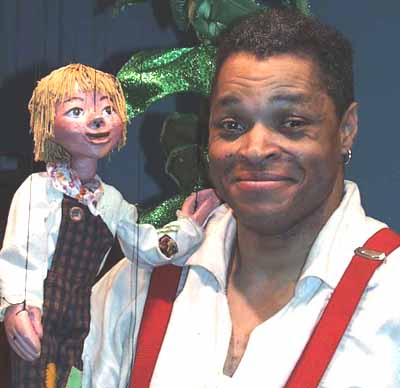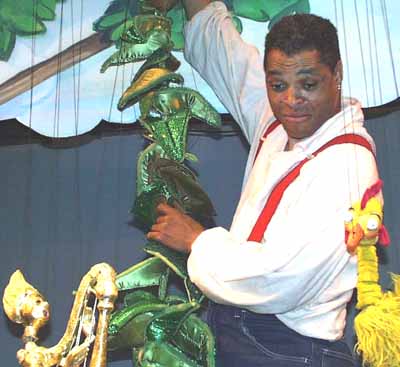
 Michael Saunders as the Giant, photo by Donald Devet |
The Swedish Cottage Marionette Theatre Central Park New York, NY March 25, 2000 reviewed by Donald Devet |
Nestled at the foot of the Shakespeare Gardens, the Swedish Cottage Marionette Theatre is a charming building which lives up to its name. It looks like something Heidi could live it. It's small like a cottage. And it's home to New York City's only government sponsored puppet company. Jack and the Beanstalk, written by Michael Alogna and Larry Aumen and directed by Bruce Cannon, is not a new show for the Cottage. It was originally performed in the 1960's. The puppets have been rebuilt and restored by Janine Schiller, David Stein and Nick Coppola (who also made the costumes and a new "Jack"). The sets are by Kevin J. Roach. Though the look of the show may be new and fresh, the audio track including music and dialogue are anything but new. This is the original soundtrack from 40 years ago. Even though there have been a few minor alterations, the tape is exactly what the parents of the young members of the audience might have listened to when they came to see this show. Revitalizing everything about Jack and the Beanstalk except the soundtrack and script is like putting a new paint job on an antique car but ignoring the fact that its guts are rusted out. The car looks great on the outside, but don't try to go anywhere in it. This script is seriously flawed. Holes in the plot, abrupt changes in tone and anachronisms galore can be overlooked. What can't be ignored is the transformation of a wonderful story into a cheesy musical with a lesson in pop psychology thrown in for good measure. First, the music. After a lengthy "overture" the curtains part to reveal Jack and his cow, Dolly, who sing and dance at the drop of an empty milk bucket. Even the kindly peddler who trades Jack the beans in exchange for Dolly has a song up his tattered sleeve. And on it goes. Everyone gets to sing-- the giant, Milford; his housekeeper, Citronella; and even the golden harp and golden egg laying chicken. And the songs are not that great. They're either derivative, lifted from other shows ("When You Wish Upon a Star") or, worst of all, just plain boring. They serve neither to advance the plot nor to reveal the charactersâ inner emotions. In addition, interminable instrumental pieces are played during lengthy scene changes while the curtains are closed. And now for the pop psychology. As a folk tale, Jack and the Beanstalk pits a wily boy against a cannibalistic giant. Jack's ingenuity in restoring the family's wealth against gargantuan odds is a triumph for the "little guy." But in the Cottage's version the juiciest moments of the story have been glossed over. Milford may be giant in stature, but as a villian, he's puny. When the Giant bellows "Fee Fi Fo Fum, I smell the blood of an Englishman," kids should be worried that at any moment Jack could become the giant's dish de jour. Instead, they were laughing. That's because Milford (played by Michael Saunders) is anything but menacing. He is only "misunderstood." He never had a real family. So instead of cutting down the beanstalk to kill the Giant, Jack beneficently invites him home to live with him and his Mom. Now Milford has a family. Not only is the script in trouble but it's been preserved for 40 years in acetate. Reworking lines are easy when a show is performed "live", but when a show is commited to tape, any changes become time consuming and costly. To tape or not to tape? This has been a question vexing puppeteers ever since the technology became available. In fairness, it's understandable why a taped show at the Cottage is necessary. A show runs all year for hundreds of performances with an interchangeable crew of puppeteers and actors; the tape offers a much needed consistency. But a taped show is truly a hindrance when an actor has to lip sync to it. Saunders does a fine job in approximating a dopey look to match the taped voice. Yet no matter how good an actor he is, his character feels canned. Any spontaneity or audience chemistry has been negated by the decision to use tape. But there are ways to integrate tape with "live" theater. Last year's show at the Cottage, Gulliver, was similar to Jack and the Beanstalk in that an actor appeared on stage with the puppets, except the actor playing Gulliver got to speak the lines LIVE. Perfectly timed with the puppetsâ taped dialogue, this approach worked. Hearing the actor's voice "live" made all the difference. What really makes Jack and the Beanstalk feel canned is the juxtaposition of the live demo done before the show and the 45 minutes of spooling Memorex that follows. In the short demo, Janine Schiller uses a clown marionette to exemplify techniques of bringing a puppet to life. She and the puppet respond to the audience. The audience responds as well. Jack and the Beanstalk should have exhibited this kind of spontaneity. Next season the Cottage will offer Sleeping Beauty which will be completely built from scratch-- puppets, sets, costumes and thankfully, the script and soundtrack. Copyright © 2000 Donald Devet |
|
 Michael Saunders as the Giant, photo by Donald Devet |
|